AMD Kaveri Review: A8-7600 and A10-7850K Tested
by Ian Cutress & Rahul Garg on January 14, 2014 8:00 AM ESTCPU Performance
I often make a big song and dance about real world benchmarks being the main focus of a reviewer. Synthetics often stress parts of the CPU and distort advantages that a CPU might have and thus not affect you or me in the same manner when using the machine normally. For 2014 I have updated my usual benchmarking set, to include more video encoding and an image converter that takes 2D images and performs algorithms to convert the data into a 3D model. Some 2013 benchmarks are still here, showing what can be done, and to bring parity to previous CPU reviews, some synthetics are also included.
Agisoft Photoscan v1.0 - link
Our new main benchmark to AnandTech is provided by Agisoft. Their Photoscan software creates 3D models from 2D images, a process which is very computationally expensive. The algorithm is split into four distinct phases, and different phases of the model reconstruction require either fast memory, fast IPC, more cores, or even OpenCL compute devices to hand. Agisoft supplied us with a special version of the software to script the process, where we take 50 images of a stately home and convert it into a medium quality model. This benchmark typically takes around 15-20 minutes on a high end PC on the CPU alone, with GPUs reducing the time.
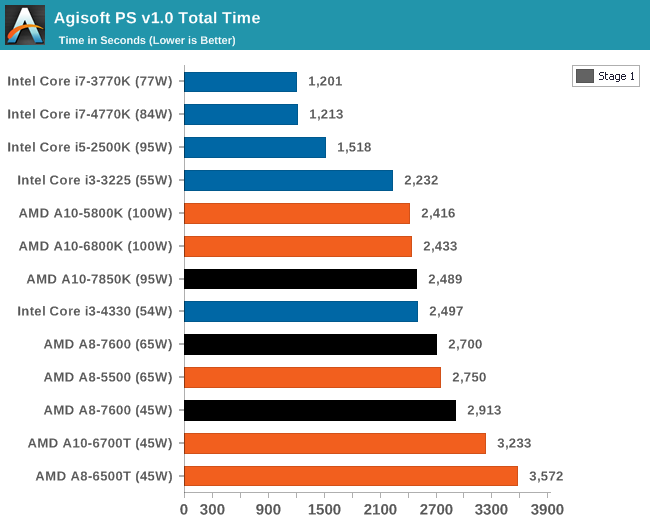
AMD suffers in overall time due to the lack of full-blooded cores and the reliance on single threaded performance in certain parts of the algorithm.
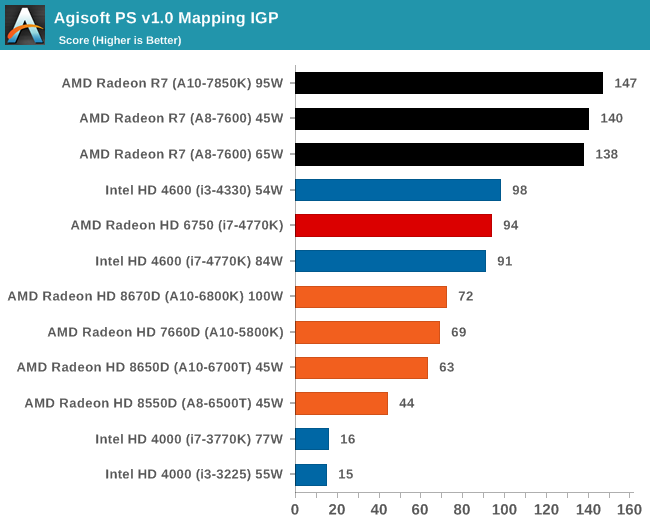
The second stage of the benchmark can be accelerated by the IGP of an APU, and as a result we can see the power of the high end APUs for this work can outshine any CPU we tested today. This is really the promise of HSA, it's just going to take a while to get there for most apps.
3D Particle Movement - link
3DPM is a self-penned benchmark, taking basic 3D movement algorithms used in Brownian Motion simulations and testing them for speed. High floating point performance, MHz and IPC wins in the single thread version, whereas the multithread version has to handle the threads and loves more cores.
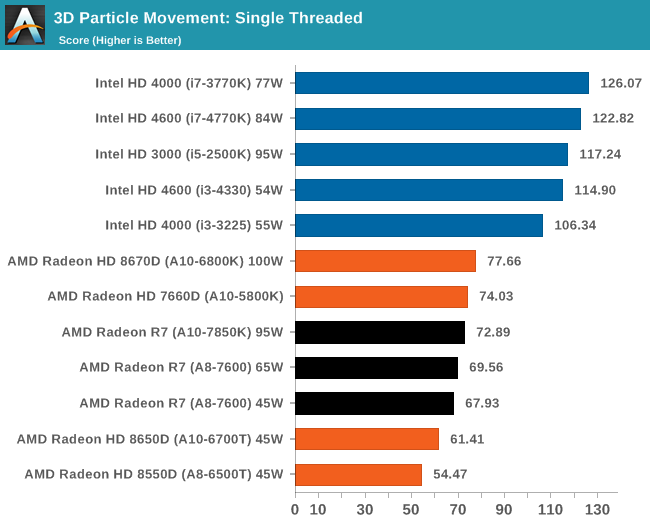
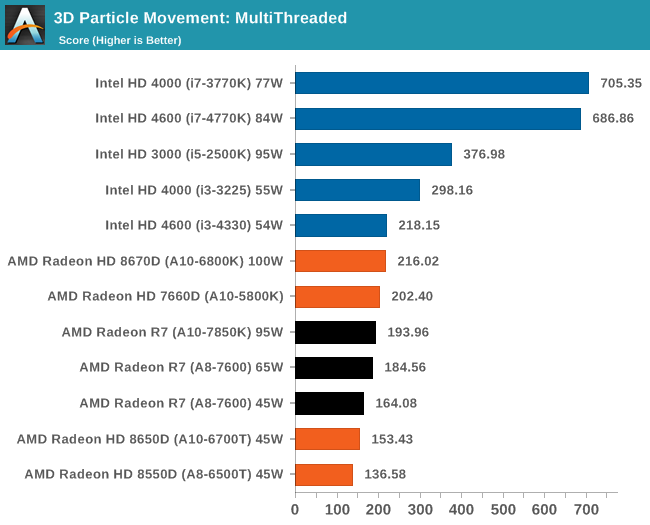
AMD is still suffering a lack of FP performance in our 3DPM benchmark.
WinRAR 5.01 - link
Our WinRAR test from 2013 is updated to the latest version of WinRAR at the start of 2014. We compress a set of 2867 files across 320 folders totaling 1.52 GB in size – 95% of these files are small typical website files, and the rest (90% of the size) are small 30 second 720p videos.
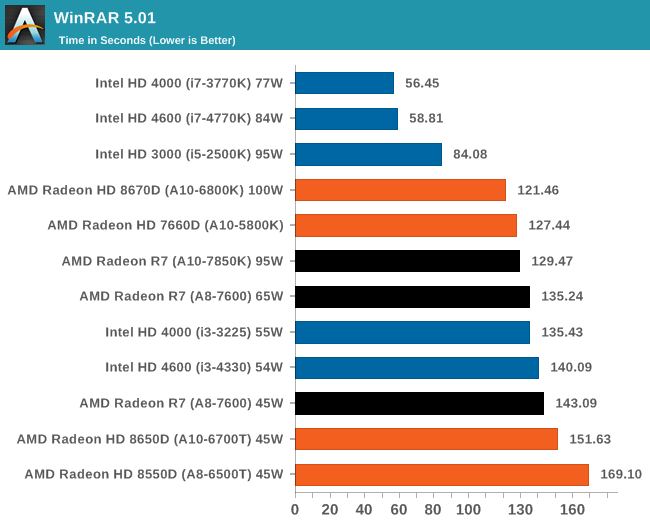
WinRAR loves IPC from the high end Intel chips, but even against the older i5-2500K there is still a deficit. The 45W Kaveri APU however is within fighting distance of its main rival.
FastStone Image Viewer 4.9 - link
Similarly to WinRAR, the FastStone test us updated for 2014 to the latest version. FastStone is the program I use to perform quick or bulk actions on images, such as resizing, adjusting for color and cropping. In our test we take a series of 170 images in various sizes and formats and convert them all into 640x480 .gif files, maintaining the aspect ratio. FastStone does not use multithreading for this test, and thus single threaded performance is often the winner.
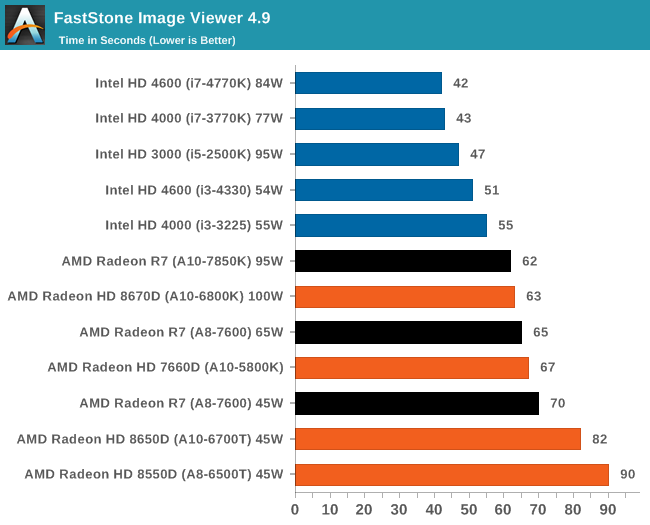
FastStone wants single threaded performance, so Intel wins here again.










380 Comments
View All Comments
fteoath64 - Sunday, January 19, 2014 - link
"Now we need a new one, a fully HSA compliant HyperTransport." Yes! The dedicated people working on new SuperComputers are doing exotic Interconnects close or exceeding 1TBytes/sec speeds but limited by distance naturally. I see that for HyperTransport 3.0 one can implement 10 channels for high aggregated bandwidth, but that will use more transistors. In a budget conscious die size, using eSRAM seems to be a good trick to boost the bandwidth without overt complexity or transistor budget. The downside is eSRAM suck constant power so it becomes a fixture in the TDP numbers. Iris PRO uses 128MB of eDRAM while Xbox One uses 32MB eSRAM. I think the least amount would be somewhere around 24MB for the x86 to be effective in getting effective RAM bandwidth high enough!.The cascading effect if that the memory controller becomes complex and eats into the transistor budget considerably. Seems like a series of moving compromises to get the required performance numbers vs power budget for TDP.
I am actually very excited to see an Arm chip implementing HSA!!.
Samus - Wednesday, January 15, 2014 - link
I don't get why AMD can't compete with Intel's compute performance like they were absolutely able to do a decade ago. Have they lost all their engineering talent? This isn't just a matter of the Intel manufacturing/fab advantage.zodiacfml - Wednesday, January 15, 2014 - link
oh no, after all that, I just came impressed with the Iris Pro. I believe memory bandwidth is needed for Kaveri to stretch its legs.duploxxx - Wednesday, January 15, 2014 - link
impressed with iris pro? for that price difference i would buy a mediocore CPU and dedicated GPU and run circles around it with any game....oaf_king - Wednesday, January 15, 2014 - link
I can point out some carpola here: "I am not sure if this is an effect of the platform or the motherboard, but it will be something to inspect in our motherboard reviews going forward." This sure discounts the major performance benefits you can achieve without faulty hardware. Search the real benchmarks on WCCF tech for A-10 7850 and be amazed. I can STRONGLY DOUBT the CPU has any issue running at 4ghz on a stock cooler/900mhz GPU. Yes the GPU overclock seems skipped over in this Anand review also, but should really pull it into the "useful" category for gaming!oaf_king - Wednesday, January 15, 2014 - link
recall AMD had some leaks suggesting 4ghz CPU / 900Mhz GPU. Is that possible after all? Apparently not all motherboards are faulty. If the TDP tops out at 148 at 4ghz, given the conservative power envelopes already placed on the chip, I'm sure it gets very good performance for between zero and ten extra dollars, and a couple seconds in the BIOS.Fox McCloud - Wednesday, January 15, 2014 - link
Maybe I was skim reading and missed it, but what are the idle power consumption figures for the A8-7600? I need a new home server and I have a iTX system, and mother boards with 6x SATA are slim. It seems the manufacturers only put them on AMD ITX boards, as Intel seem to max out at like 4. I wonder what power figures would be like if under clocked also. I might re-read the review!Excellent review as always guys. So in-depth, informative, technical and unbiased. This is why I love this site and trust your expert opinion :)
Zingam - Wednesday, January 15, 2014 - link
AMDs PR: "The processor that your grandparents dream of!" FYEAHA!keveazy - Wednesday, January 15, 2014 - link
My i5 4440 costs the same as the a10-7850k. I don't think amd will ever compete. By the time they release something that would declare a significant jump, Intel would already have something new to destroy it by then.duploxxx - Wednesday, January 15, 2014 - link
compete to do what? general tasks in a day, just buy an SSD... cost? did check your motherboard price? GPU, did you check the 4600 performance vs a10? it runs circles around it unless you want to be stuck on low resolution with your gorgeous fast cpu.you see customers fool themselve not knowing what to buy for what. hey i have the best benchmarking cpu, but on daily tasks i can't even count the microseconds difference.